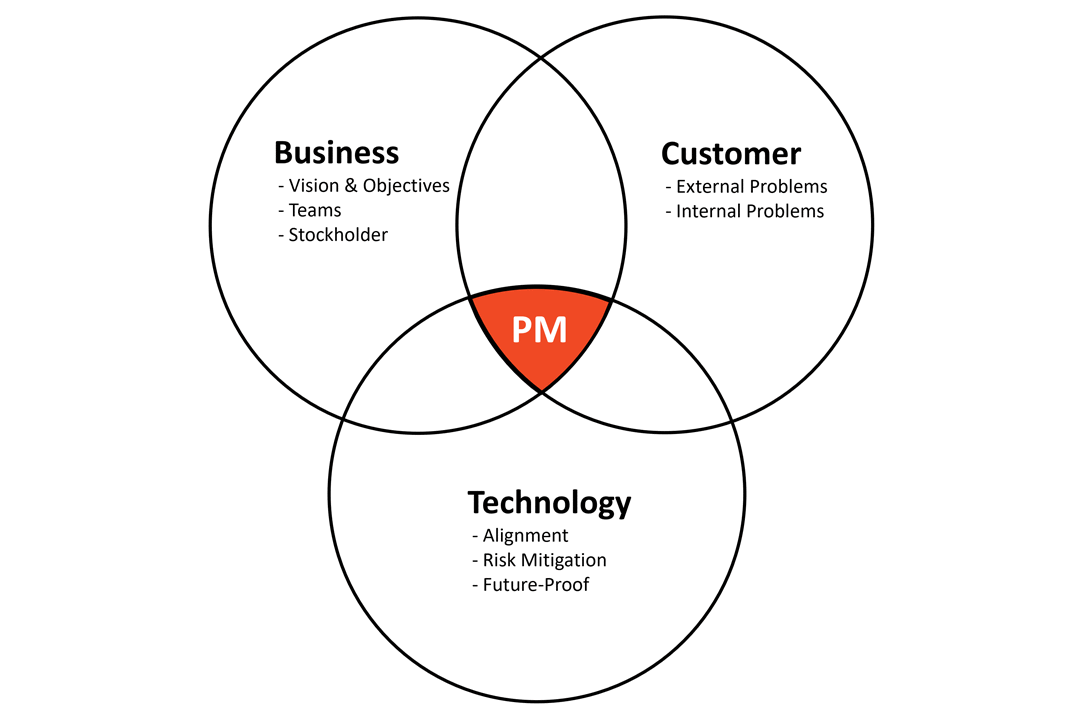A Product Manager (PM) thrives in the space between people. They act as the central hub, regularly interacting with three key segments:
- Customers: The lifeblood of any product, providing invaluable insights and shaping the direction of development.
- Business: The driving force behind the product, offering strategic guidance and ensuring its viability.
- Technology: The architects who bring the product to life, translating vision into reality.
Each segment contributes critical data and perspectives. The PM's responsibility lies in refining this information, filtering out the irrelevant, and presenting it in a clear and actionable manner for the other segments.
But the true essence of a successful PM lies in their collaborative spirit. They rely heavily on the engagement and expertise of others, while simultaneously serving as a guide, offering insights, knowledge, and direction.
A PM has the power to influence the journey of discovery, creation, and decision-making. However, they are not the hero of the story - they are the guide, leading others towards shared success.
Customer
Understanding the Customer and discovering their External and Internal Needs
A crucial component of a PM's role is fostering a close relationship with both existing and potential customers. This requires the ability to look beyond the curtain, actively listen, read between the lines, and recognize that customers ultimately seek solutions to their problems.
It's important to understand that customers have two distinct problems:
- External Problem: This is the readily apparent issue they are actively trying to solve.
- Internal Problem: This is the underlying motivator, often emotional or psychological, driving the desire to solve the external problem. Both problems are inextricably linked, and customers expect a successful product to address both.
Example of an External vs. Internal Problem
- External Problem: "I need a lawnmower to cut my grass."
- Internal Problem: "My garden appears messy compared to my neighbor’s."
While customers actively search for solutions to the external problem, it's the PM's responsibility to uncover and understand the underlying internal problem. This deeper understanding allows for the development of a more effective solution.
In the example above, a successful product wouldn't just be a lawnmower; it would be a “quiet, efficient, lightweight, user-friendly, and visually pleasing machine that tracks usage over time”.
While some features address the external problem (cutting grass), others tackle the internal desire (aesthetics, feeling of control). This comprehensive approach sets the product apart from the competition, making it the standout choice among the other 50 brands a customer might consider.
Business
The Balancing Act between Customer Problems and Business Objectives
While addressing customer problems is the core of each product, a successful Product Manager (PM) must also ensure those problems align with the company's overall vision and objectives. Imagine a heavy equipment manufacturer focusing on small lawnmowers instead of heavy construction equipment – a misalignment that could lead to wasted resources and missed opportunities.
PMs need a deep understanding of their company's business strategy and ensure their product roadmap aligns seamlessly with it. They must demonstrate how their product contributes to key metrics like revenue generation, market share, and profitability. On the contrary, a business might prioritize initiatives based on specific goals, like focusing on one specific market segment or optimizing existing products before implementing new solutions. This interplay between customer needs and business objectives is crucial for ensuring product and business success.
Furthermore, PMs need to have a clear understanding of the financial feasibility of proposed features and requirements. Key performance indicators (KPIs) and return on investment (ROI) must be clearly defined, and product success parameters established. This lays the groundwork for effective pricing strategies and sustainable revenue models. Collaboration with marketing teams becomes vital. Developing and executing together go-to-market strategies while Identifying the right marketing channels and crafting compelling messaging ensures the product reaches its target audience effectively.
Strong communication and leadership skills are also required when it comes to internal collaboration, to inspire and motivate cross-functional teams, clearly communicate the product vision, and manage any potential conflicts. Building strong relationships with stakeholders across various professions, from executives to sales and marketing, engineering and design, and even support and operations, is crucial. This enables them to act on incoming information, adapt to a dynamic environment, and adjust roadmaps and strategies in response to market trends and customer feedback.
Ultimately, a PM's strategic thinking allows them to plan for the product's future. They need a long-term vision that aligns with the company's overall strategy and effectively guides the team towards shared success.
Technology
Navigating the Tech Landscape: A Product Manager's Technical Proficiency
While a Product Manager (PM) doesn't necessarily need to be a coding or engineering expert, a solid understanding of technology is crucial for their success. As the bridge between customers, business, and technology, PMs must navigate the technical feasibility of ideas, clearly communicate product vision to engineers, and translate user needs into actionable technical requirements. Lacking this understanding can lead to miscommunication, delays, and ultimately, suboptimal products.
A PM's ability to make informed decisions about features, roadmaps, and resource allocation is often limited by their understanding of technical potential and possibilities. They need to critically evaluate different solutions, considering both their strengths and limitations, to ensure optimal results.
Their technical knowledge extends beyond internal collaboration. When interacting with technology vendors, PMs need a solid understanding of the landscape to negotiate effectively and design products that remain competitive in a constantly evolving market. This proficiency allows them to identify new trends and opportunities, stay ahead of the curve, and ensure product competitiveness.
Understanding the technical complexities of a project enables them to manage expectations and easily communicate potential risks to stakeholders while building trust between the engineers. PMs who can "speak the language of engineers" are better equipped to mitigate risks, appreciate the efforts of their engineering team, and plan effectively. This positions them as credible leaders and effective collaborators.
